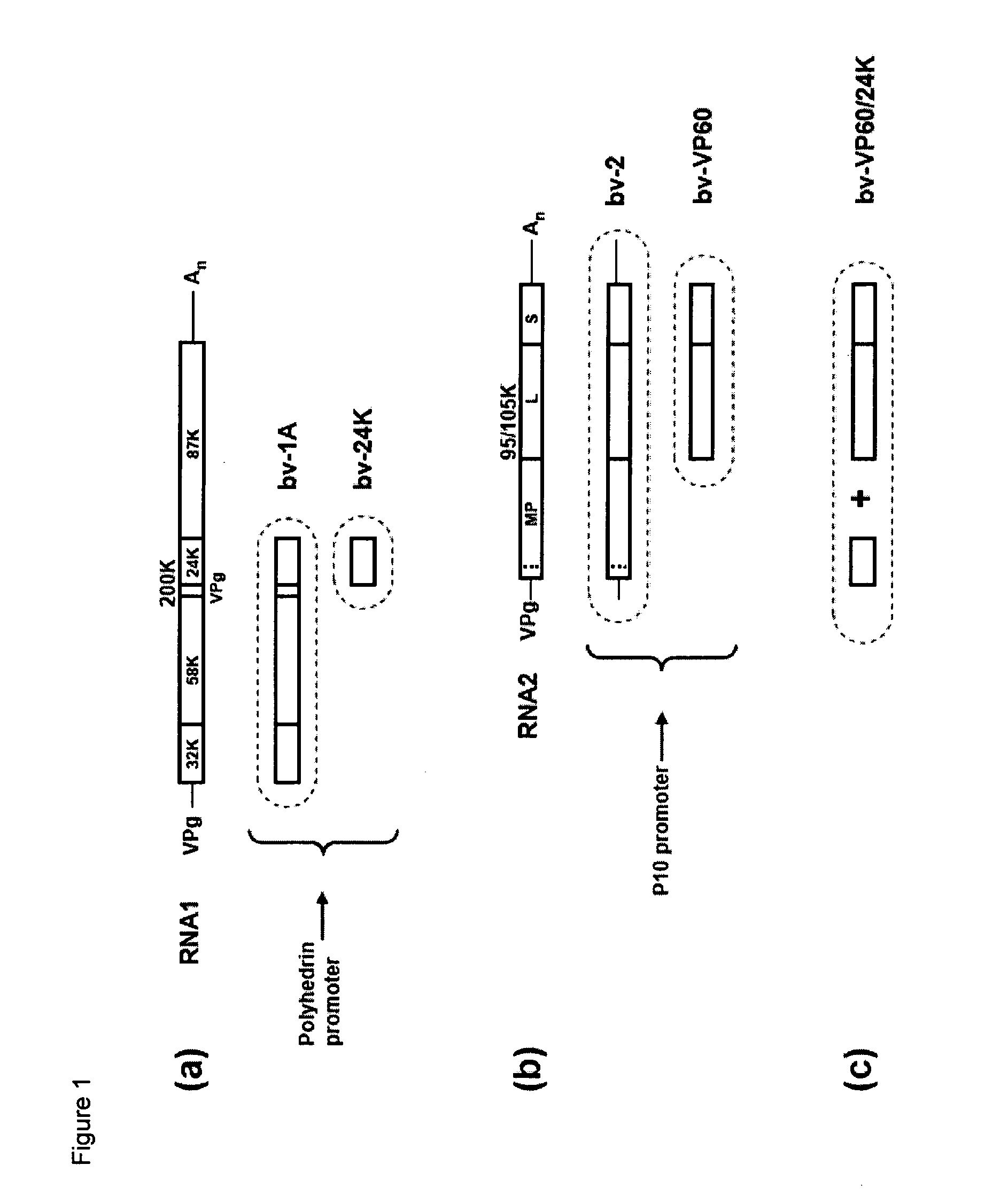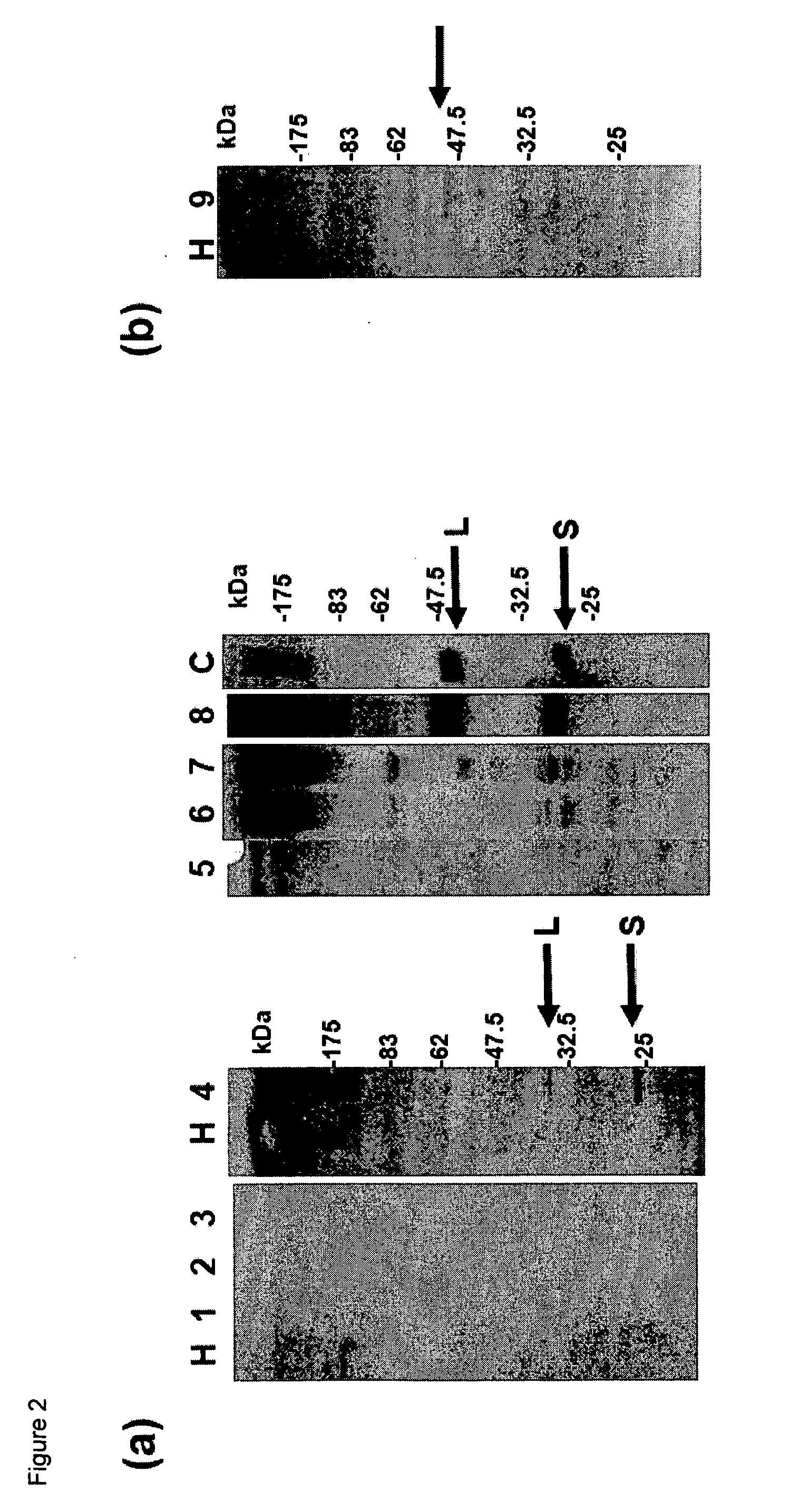Production of viral capsids
- Summary
- Abstract
- Description
- Claims
- Application Information
AI Technical Summary
Benefits of technology
Problems solved by technology
Method used
Image
Examples
example 1
Processing of the RNA-2-Encoded Polyproteins in Trans in Insect Cells to Give the L and S Coat Proteins Requires Both the 24K Proteinase and the 32K Proteinase Co-Factor
[0229]A full-length cDNA clone of RNA 2 was assembled in the baculovirus expression vector pMFBD so that upon transcription the entire nucleotide sequence of RNA-2 would be generated (FIG. 1). Recombinant baculovirus, bv-2, was then produced by transposition of E. coli DH10bac with the pMFBD recombinant plasmid. The resulting recombinant baculovirus DNA was transfected into the Bac-to-Bac expression system (Invitrogen) to test for the expression of both the 105 and 95K CPMV polyprotein precursors. Examination by western blotting of three independently derived samples of Sf21 cells transfected with this construct using an antibody raised against CPMV capsids failed to detect protein products of these sizes (FIG. 2a lanes 1 to 3). This result was not surprising as both the 105 and 95K polyproteins are known to be unsta...
example 2
Processing of VP60 in Trans to Give the L and S Coat Proteins Requires Only the 24K Proteinase in Insect Cells
[0232]To examine whether VP60 can act as a precursor for the mature L and S protein, a cDNA clone, bv-VP60, was constructed which contains the sequence from RNA-2 encoding VP60 (FIG. 1). Translation iniation was designed to occur from the methionine which forms the N-terminal residue of the L protein, with termination occurring at the natural stop codon downstream of the S protein. Western blot analysis using anti-CPMV capsid antiserum of extracts of Sf21 cells transfected with bv-VP60 showed the presence of a protein of approximately 60 kDa which corresponds in size to VP60; a protein of a size which could represent a C-terminally truncated form of the S coat protein was also seen in low abundance (FIG. 2a, lane 6). Co-infection of Sf21 cells with bv-VP60 and bv-1A resulted in the appearance of both the L and S coat proteins as well as some residual VP60 (FIG. 2a, lane 7). ...
example 3
The L and S Proteins Produced by Proteolytic Processing in Trans can Assemble into VLPs in Insect Cells
[0233]To ascertain whether the L and S proteins resulting from in trans proteolytic processing of precursor polypeptides can assemble into VLPs, extracts of infected cells were prepared and analysed by sucrose gradient density centrifugation. As a control, a preparation of CPMV particles isolated from plants was analysed in parallel. The positions of the L and S proteins in the gradients were determined by western blot analysis, using anti-CPMV, antibodies of samples of each fraction. In the case of CPMV particles isolated from infected plants, most of the L and S protein is found in fractions from the middle of the gradient (FIG. 3a). This represents the sedimentation of the Middle and Bottom components of CPMV, containing RNA-2 and RNA-1, respectively. The small amounts of the L and S proteins in the fractions at the top of the gradient are derived from the relatively low levels ...
PUM
| Property | Measurement | Unit |
|---|---|---|
| Temperature | aaaaa | aaaaa |
| Fraction | aaaaa | aaaaa |
| Fraction | aaaaa | aaaaa |
Abstract
Description
Claims
Application Information
 Login to View More
Login to View More - Generate Ideas
- Intellectual Property
- Life Sciences
- Materials
- Tech Scout
- Unparalleled Data Quality
- Higher Quality Content
- 60% Fewer Hallucinations
Browse by: Latest US Patents, China's latest patents, Technical Efficacy Thesaurus, Application Domain, Technology Topic, Popular Technical Reports.
© 2025 PatSnap. All rights reserved.Legal|Privacy policy|Modern Slavery Act Transparency Statement|Sitemap|About US| Contact US: help@patsnap.com



